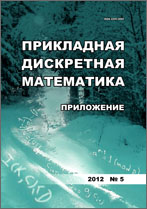|
Computational methods in discrete mathematics
Computational experiments in finite two generator Burnside groups of exponent five
A. A. Kuznetsov
M. F. Reshetnev Siberian State University of Science and Technologies
Abstract:
Let $B_0(2,5)=\langle a_1,a_2 \rangle$ be the largest two generator Burnside group of exponent five. It has the order $5^{34}$. There is a power commutator presentation of $B_0(2,5)$. In this case every element of the group can be represented uniquely as $a_1^{\alpha_1}\cdot a_2^{\alpha_2}\cdot\ldots\cdot a_{34}^{\alpha_{34}}$, $\alpha_i \in \mathbb{Z}_5$, $i=1,2,\ldots,34$. Here $a_1$ and $a_2$ are generators of $B_0(2,5)$, commutators $a_3,\ldots,a_{34}$ are defined recursively by $a_1$ and $a_2$.
We define $B_k=B_0(2,5)/\langle a_{k+1},\ldots,a_{34}\rangle$ as a quotient of $B_0(2,5)$, $|B_k|=5^k$.
Let $\varphi $ be the homomorphism of $ B_k $ onto the group $ Q_k $ and $ N_k $ be the kernel of $\varphi $. We have done some computational experiments and now formulate a hypothesis about the diameter $D_{A_4}(B_k)$ of the $B_k$ relative to the symmetric generating set $A_4 = \{ a_1,a_1^{-1},a_2,a_2^{-1}\}$: $D_{A_4}(eN_k) = D_{A_4}(B_k)$ for all $2\leq k \leq 34$ where $|N_k| \sim|Q_k| \sim |B_k|^{{1}/{2}}$, $e$ is the identity of $B_k$ and $D_{A_4}(eN_k)$ is the diameter of the coset $eN_k$. Note that this hypothesis is correct for $k \leq 19$.
Keywords:
Burnside group, the growth function.
Citation:
A. A. Kuznetsov, “Computational experiments in finite two generator Burnside groups of exponent five”, Prikl. Diskr. Mat. Suppl., 2019, no. 12, 216–218
Linking options:
https://www.mathnet.ru/eng/pdma475 https://www.mathnet.ru/eng/pdma/y2019/i12/p216
|

| Statistics & downloads: |
| Abstract page: | 117 | | Full-text PDF : | 31 | | References: | 20 |
|




 Contact us:
Contact us: Terms of Use
Terms of Use
 Registration to the website
Registration to the website Logotypes
Logotypes








 Citation in format
Citation in format 